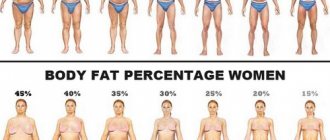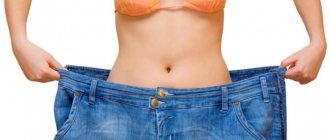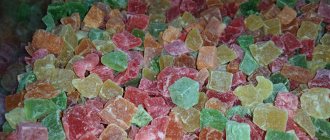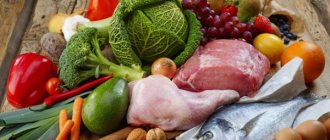What determines the calorie content of fresh fruits and berries?
For convenience, calorie data is presented in the form of tables. But these are average numbers. In fact, the number of calories in fruits or berries may fluctuate. This is due to the characteristics of the fruit:
- The riper and sweeter, the more sugar and calories.
- Frozen ones are lower in calories because they contain more water.
- The calorie content of dried or cured fruits is three to six times higher than that of fresh ones.
- The denser the pulp, the higher the calorie content of the berry and fruit.
Slightly unripe specimens are more suitable for those losing weight - they have more fiber and less sugar than ripe ones. Or ripe, but not too dense and sweet.
The calorie content is significantly influenced by where the tree grew and the fruits ripened: climate, soil characteristics, range of fertilizers applied, and other factors.
However, it is important not only how many calories are in, for example, an apple or pineapple, but also the balance. We are talking about the “quadrangle” of KBJU of a fruit or berry. That is, the tables reflect the calorie content, amount of proteins, fats, carbohydrates of berries or fruits per 100 grams. Then the diet will be correct, and the result of the diet will be optimal.
Weekly fruit diet menu
You don’t need to prepare your body in advance for a tasty and healthy diet; you just need to write out your menu for the week ahead and carefully follow it. But, if you have doubts about the exposure, you should start with 3 days, increasing to 7 or even 12 days.
| Day of the week | Breakfast | Lunch menu | Dinner |
| Monday | Any fruit, a glass of freshly squeezed juice | Fruit salad with yogurt, mug of water | Fruit salad mix, seasoned with lemon juice, a mug of juice |
| Tuesday | 2 any fruits, a mug of water | Fruit salad with dressing of your choice, a cup of water | 1 serving of cooked vegetables, two citrus fruits |
| Wednesday | Fruit salad from fresh fruits, freshly squeezed juice | Fruit salad mix with dressing of your choice, a glass of water | Vegetable soup 1 serving |
| Thursday | Bowl of berries, mug of water | 2 any fruits, freshly squeezed juice | 1 juicy fruit |
| Friday | Day to unload the body, eat one type of fruit and water | ||
| Saturday | Fruit and berry smoothie | Mixed fruit salad without dressing, a cup of green tea | 2 apples, freshly squeezed juice |
| Resurrection | Any 3 fruits | Fruit and berry salad, a mug of water | 1 serving of vegetable soup, freshly squeezed juice |
Keep your caloric intake at a normal level, choose the right fruits, analyze the tables - by doing these minimal actions, you can deprive your body of 10 kg in a week. It is important to find a balance, not to overdo it, so as not to harm the body.
Article design: Vladimir the Great
Which fruits have the most calories?
High-calorie fruits are also used to increase body weight. This option is useful when kids have no appetite, and teenagers are “tired of everything,” but a source of energy is needed for the growing body.
Here's what the list of high-calorie fruits looks like (per 100 g):
- Avocado, calorie content 168-170 calories. One of the most nutritious fruits, a source of potassium, monounsaturated fatty acids. High-calorie fruits seem to duplicate fatty fish varieties. The green, oily fruit “organizes” the process of assimilation by the body of even problematic foods. Good as a “fatty” ingredient in salads or light snacks.
When fresh, the most high-calorie fruit in the world is the avocado. Nutritionists and calorie table compilers agree with this.
- Banana, 87-89 calories. A source of potassium and easily digestible sugars, it is therefore indispensable if you need to restore strength instantly. Potassium supports the heart. The fruit does not cause allergies, and the amino acid tryptophan in the body is converted into the joy hormone serotonin. The high calorie content of bananas should not alarm you: the glycemic index is moderate.
- Mango, 65-67 calories. The exotic, high-calorie fruit inhibits cancer and aging. It is a powerful antioxidant that prevents atherosclerosis. Facilitates the digestibility of meat dishes.
- Persimmon, 64-66 calories. Useful for all body systems. Tannins create an astringent effect. This is a beauty fruit for ladies and metrosexual men. In dried form, it quickly restores strength and eliminates anemia, but the calorie content is four times higher. If you have problems with the gastrointestinal tract, you should not abuse it.
- Figs, 56-58 calories. Rich in fiber, vitamins, antioxidants. Good for hearts. However, it is more often available in dried form, so the calorie content must be multiplied by three.
- Papaya, 50-53 calories. It is famous for the presence of papain, which breaks down proteins without problems. Fresh or frozen exotics from the supermarket are equally useful.
- Pomegranate, 49-51 calories. Guardian of health and blood quality. Indicated for anemic people with thyroid problems. Inhibits the development of tumors and infections. Particularly in demand when there are no fresh local fruits (winter-spring).
- Nectarine, 48-50 calories. A sweet variety of peach. Potassium monitors blood vessels, the heart; Vitamin B17 (amygdalin) destroys cancer cells. The remaining components regulate the functioning of the gastrointestinal tract and other organs, making the skin and hair beautiful. It is better to eat fruit without sugar.
- Quince, 47-49 calories. Strengthens the heart, blood vessels, nerves. Treats acute respiratory infections, anemia, removes toxins. However, it increases appetite.
Fruit diet: basic principles
Thanks to fruits, you can reduce your weight by 4-5 kg in a week without feeling hungry and maintaining a positive mood. The fruit diet is based on eating only fruits and berries in unlimited quantities; you just have to choose which fruits you want to see in your diet.
- One or many. A menu that contains only one type of fruit is more effective, but one that contains a combination of several types is easier for the body to adapt to.
- Fermented milk supplement. By eating only fruits, you cannot get the daily intake of essential nutrients, so the diet is supplemented with kefir, yogurt or milk. This combination of products allows you to prepare delicious and healthy salads and smoothies.
- Choosing the right fruits for your diet. It is recommended to give preference to:
- apples;
- grapefruits;
- pineapples;
- peaches;
- oranges.
Juices and light salads can be easily prepared from the above, but it is best to consume them raw, then they will fully release their microelements, vitamins and minerals.
It is not recommended to include bananas, grapes, and dried fruits in your diet.
- Drinking regime. Water should be drunk in the amount of 1.5 liters per 24 hours, thus starting the process of assimilation of fruits.

- Without measure. There is no specific amount of fruit allowed by the diet; it is recommended not to reach the feeling of hunger, and to eat small portions every few hours.
The fruit menu should not be followed for more than 10-12 days, during which time diarrhea and weakness may occur.
Fruits cannot provide all the necessary proteins and vitamins, which leads to disastrous consequences if consumed for a long time on such a diet. This diet is contraindicated for people with an allergic reaction, high acidity in the body, as well as intolerance to fruits.
Lowest calorie fruits
Tables of low-calorie fruits for weight loss include items for every taste and income. Among them are native and exotic species:
- Lemon, calorie content 32-34 calories per 100 g. Citrus is an officially recognized store of vitamin C. Useful in spring or autumn, during the acute respiratory infections season. But restrictions need to be taken into account, especially for people with gastrointestinal problems.
- Grapefruit, 35-37 calories. The red varieties are considered the most valuable. Endowed with the ability to burn fat, suppress appetite, and remove excess fluid. A set of nutrients (including fiber) helps the functioning of the gastrointestinal tract and liver. Strengthens the immune system, the walls of blood vessels, neutralizes depression and insomnia. Sugars are absorbed slowly and make a good evening snack.
There are no citrus fruits in the tables of the most high-calorie fruits - their indicator is lower than the average values.
- Apricot, 40-42 calories. The main trump card of the fruit is its saturation with magnesium and phosphorus. These elements activate the brain and strengthen memory. Beta-carotene strengthens vision, inhibits the occurrence of cancer, and protects heart health. The oranger the fruit, the better. Dried fruits (dried apricots) have six times the calorie content.
- Plum, 42-44 calories. The main components of the vitamin set are K and group B. Plus potassium, calcium, iron, magnesium, phosphorus, natural acids (citric, malic, oxalic). Solves problems of constipation and the genitourinary system. Cleanses the body, normalizes metabolism, which is useful for weight watchers.
- Pear, 43-46 calories. The pulp is rich in vitamins B1, C, P, fructose, and other natural sugars. Seeds are a natural source of iodine. Even in sweet juicy varieties, excess sugar content was not recorded.
- Kiwi, 46-49 calories. Exotic with a set of useful macro- and microelements, vitamins, fiber. The last nutrient quickly saturates the body, which is valuable during diets. There is more vitamin C than citrus fruits.
- Apples, 47-49 calories. Rich in iron, phosphorus, vitamin C, pectin. Pectins radically rid the body of toxins, cleanse fluids (blood, lymph) and blood vessels. If consuming fresh is problematic, it is better to bake the apple in the oven.
- Pineapple, 48-50 calories. Unique in the presence of bromelain. This enzyme is the number one fat burner. There are almost no contraindications; digestion and metabolism are normalized.
Your personal table of low-calorie fruits can be supplemented with tangerines, oranges (37-38 calories each), and peaches.
A separate story is watermelon (23-25 calories) and melon (38-40). These are not fruits, but melons. But they are 60-80% water (especially watermelon). Cleanses the liver, flushes the kidneys, lycopene inhibits aging. During the season, it is a mandatory dietary product, regardless of the type or severity of the diet.
Calorie content of berries
The assortment of berries familiar to most is varied. According to the tables, the average caloric value of fresh fruits is 57-60 kcal/100 g.
The most high-calorie berries
Calorie tables define the hierarchy of the highest calorie types:
- Sea buckthorn, calorie content 80-82 per 100 g. “Ginseng” of the south and central Russia. Removes cholesterol and lowers blood pressure for a long time. Restores cell membranes damaged by “chemistry”. But for those prone to obesity, this high-calorie product is conditionally suitable.
- Grapes, 53-79 calories. The least high-calorie white grapes, the most “nutritious” are dark blue ones. It is recommended to consume with skin and seeds. Useful for heart patients, anemic people, and asthmatics.
- Cherry, 49-52 calories. Removes toxins and quenches thirst well. But there are contraindications.
- Blueberries, 42-44 calories. The main natural guardian of vision. Reduces inflammatory processes, helps with chronic inflammation. 100 g of fruits is the daily requirement of vitamin C.
- Raspberries, 41-43 calories. Berry champion in manganese and zinc content. Proven folk antipyretic remedy. Strengthens the walls of blood vessels, breaks down fats without problems.
Conclusion
Having set a goal to lose weight, gain weight or get healthier, it is wise to create a personal “calorie” table with your favorite foods.

In order for fruits and berries, especially high-calorie ones, to be beneficial, you need to consume them wisely. This is a traditional dessert for us, but, for example, the ancient Greeks began their meals with them. And they were right: fruits are digested faster than meat and other ingredients of main dishes. If they are consumed immediately after a substantial meal, fermentation will begin in the stomach. It is more rational to enjoy fruit or berries half an hour to forty minutes before meals or as an independent snack.
Calorie table for fruits and berries
| Name of fruit | kcal | squirrels | fats | carbohydrates |
| Apricot | 41 | 0.9 | 0.1 | 10.8 |
| Avocado | 208 | 2.0 | 20.0 | 7.4 |
| Quince | 48 | 0.6 | 0.5 | 8.9 |
| Cherry plum | 27 | 0.2 | — | 6.9 |
| A pineapple | 52 | 0.3 | 0.1 | 11.8 |
| Canned pineapple | 57 | 0.1 | 0.1 | 14.0 |
| Orange | 43 | 0.9 | 0.2 | 8.4 |
| Pickled orange | 37 | 0.6 | — | 8.9 |
| Pomegranate | 52 | 0.9 | — | 13.9 |
| Grapefruit | 29 | 0.7 | 0.2 | 6.5 |
| Pear | 57 | 0.4 | 0.13 | 15.4 |
| Guava | 68 | 2.6 | 1.0 | 8.9 |
| Strawberry guava | 63 | 0.6 | 0.6 | 17.4 |
| Jackfruit | 94 | 1.4 | 0.3 | 22.4 |
| Dragon fruit | 50 | 0.5 | 0.3 | 12.0 |
| Durian | 147 | 1.5 | 5.4 | 23.4 |
| Melon | 33 | 0.6 | 0.3 | 7.4 |
| Star apple | 67 | 0.5 | 0.4 | 15.3 |
| Carambola | 31 | 1.0 | — | 7.0 |
| Kiwano | 44 | 1.8 | 1.3 | 7.6 |
| Kiwi | 47 | 0.8 | 0.4 | 8.1 |
| Clementines | 47 | 0.9 | 0.2 | 10.3 |
| Kumquat | 71 | 1.9 | 0.9 | 9.4 |
| Lime | 16 | 0.9 | 0.1 | 3,0 |
| Pickled lemon | 21 | 0.4 | 0.3 | 6.5 |
| Lemon | 34 | 0.9 | 0.1 | 3.0 |
| Lychee | 65 | 0.8 | 0.3 | 14.4 |
| Longan | 60 | 1.3 | 0.1 | 14.0 |
| Mango | 67 | 0.5 | 0.3 | 11.5 |
| Mangosteen | 62 | 0.6 | 0.3 | 14.0 |
| Mandarin | 33 | 0.8 | 0.2 | 7.5 |
| Canned mandarin | 37 | 0.6 | 0.3 | 8.9 |
| passion fruit | 68 | 2.4 | 0.4 | 13.4 |
| Marula | 48 | 0.6 | 0.5 | 9.6 |
| Medlar | 53 | — | — | 12.0 |
| Loquat japonica | 47 | 0.4 | 0.2 | 10.4 |
| Nectarine | 48 | 0.9 | 0.2 | 11.8 |
| Noina | 47 | 0.4 | 0.4 | 9.8 |
| Noni | 44 | 0.1 | 0.3 | 10.0 |
| Papaya | 48 | 0.6 | 0.1 | 9.2 |
| Peach | 46 | 0.9 | 0.1 | 11.3 |
| Canned peach | 97 | 0.5 | 0.1 | 13.7 |
| Pomelo | 32 | 0.6 | 0.2 | 6.7 |
| Rambutan | 82 | 0.6 | 0.2 | 19.0 |
| Salak | 50 | — | — | 12.0 |
| Sapodilla | 83 | 0.4 | 1.1 | 14.7 |
| Sapota | 134 | 2.1 | 0.6 | 31.2 |
| Southep | 46 | 0.5 | 0.1 | 8.0 |
| Sweetie | 58 | 0.7 | 0.2 | 9.0 |
| Plum | 42 | 0.8 | 0.3 | 9.6 |
| Tangerine | 53 | 0.8 | 0.3 | 11.5 |
| Citron | 34 | 0.9 | 0.1 | 3,0 |
| Citron Hand of Buddha | 34 | 0.9 | 0.1 | 3,0 |
| Yuzu | 21 | 0.5 | 0.1 | 7.0 |
| Apples | 47 | 0.4 | 0.4 | 9.8 |
| Fuji Apple | 71 | 0.4 | 0.2 | 19.1 |
| Banana | 95 | 1.5 | 0.2 | 21.8 |
| Name of berries | kcal | squirrels | fats | carbohydrates |
| Watermelon | 25 | 0.6 | 0.1 | 5.8 |
| Canned watermelon | 37 | 0.5 | 0.1 | 9 |
| Barberry | 29 | — | — | 7.9 |
| Hawthorn | 52 | — | — | 14 |
| Cowberry | 43 | 0.7 | 0.5 | 9.6 |
| Soaked lingonberry | 24 | 0.3 | 0.2 | 5.3 |
| Elder | 73 | 0.7 | 0.5 | 11.4 |
| Grape | 65 | 0.6 | 0.2 | 16.8 |
| Cherry | 52 | 0.8 | 0.5 | 11.3 |
| Blueberry | 35 | 1 | — | 8.2 |
| Blackberry | 31 | 2 | — | 6.4 |
| Honeysuckle | 30 | — | — | 8 |
| Strawberries | 34 | 0.8 | 0.4 | 11.2 |
| Figs | 49 | 0.7 | 0.2 | 13.7 |
| Irga | 45 | — | — | 12 |
| Kalina | 26 | — | — | 7 |
| Strawberry | 30 | 0.6 | 0.4 | 7 |
| Cranberry | 26 | 0.5 | — | 6.8 |
| Prince | 26 | — | — | 7 |
| Gooseberry | 43 | 0.7 | 0.2 | 12 |
| Schisandra | 11 | 1 | — | 1.9 |
| Raspberries | 42 | 0.8 | 0.3 | 14.1 |
| Juniper | 116 | — | — | 31.0 |
| Cloudberry | 28 | 0.8 | — | 9.8 |
| Sea buckthorn | 52 | 0.9 | 2.5 | 10.2 |
| Rowan | 43 | 1.4 | 0.1 | 11.8 |
| White currant | 38 | 0.3 | — | 11.7 |
| Red currants | 39 | 0.6 | 0.2 | 11 |
| Black currant | 38 | 1 | 0.2 | 11.5 |
| Cherries | 50 | 1.1 | 0.4 | 11.5 |
| Blueberry | 44 | 1.1 | 0.6 | 11 |
| Chokeberry | 52 | 1.5 | 0.1 | 13.6 |
| Rose hip | 51 | 1.6 | — | 14 |
Nutritional value of dried fruits
Dried fruits can be seen on the table all year round, unlike fresh ones. They are characterized by high calorie content, which is convenient for a quick and nutritious snack.
100 g of product contains:
- 0 g fat;
- 2.8 g protein;
- 53.1 g carbohydrates;
- 216.3 kcal.
Both fruits and berries are now dried, so you can find dried fruits in stores and markets:
- apples;
- pears;
- apricots;
- figs;
- bananas and much more.
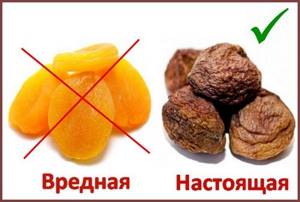
The benefits of the composition of these fruits are proven by the minerals they contain in the form of calcium, phosphorus, and iron. During dehydration, vitamin C is partially lost. Eating dried fruits makes bones strong, nerves resistant, nail plates and hair follicles beautiful and healthy thanks to calcium.
It is not recommended to eat dried fruits in large quantities for diabetics and those who want to lose weight, people with exacerbation of ulcers of the duodenum, stomach and intestines.
| Name | in 100 g | |
| kcal | Used | |
| Dried grapes | 271 | 1,7/-/65 |
| Fig/fig fruit | 257 | 3,1/0,7/57,7 |
| Dried plum | 241 | 2,2/-/58,3 |
| Dried apricot | 240 | 5,3/-/54 |
| Dried date palm fruits | 305 | 2/0,5/72,3 |

